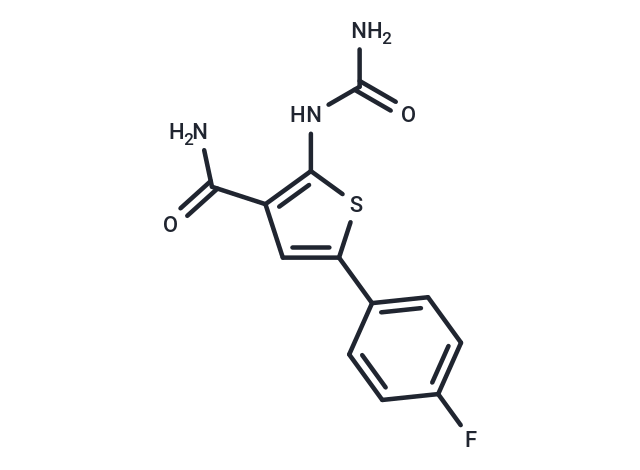Shopping Cart
- Remove All
 Your shopping cart is currently empty
Your shopping cart is currently empty

TPCA-1 (TPCA1) is an effective and specific IKK-2 inhibitor (IC50: 17.9 nM); shows >22-fold selectivity over IKK-1 and >550-fold selectivity over others kinases and enzymes.

| Pack Size | Price | Availability | Quantity |
|---|---|---|---|
| 2 mg | $38 | In Stock | |
| 5 mg | $61 | In Stock | |
| 10 mg | $97 | In Stock | |
| 25 mg | $175 | In Stock | |
| 50 mg | $288 | In Stock | |
| 100 mg | $446 | In Stock |
| Description | TPCA-1 (TPCA1) is an effective and specific IKK-2 inhibitor (IC50: 17.9 nM); shows >22-fold selectivity over IKK-1 and >550-fold selectivity over others kinases and enzymes. |
| Targets&IC50 | IKK2:17.9 nM |
| In vitro | TPCA-1 significantly reduces collagen-induced T-cell proliferation in vivo. Administering TPCA-1 (3/10/20 mg/kg, i.p., b.i.d.) prophylactically results in a dose-dependent reduction in the severity of collagen-induced arthritis (CIA) in mice. Specifically, TPCA-1 at 20 mg/kg (i.p., b.i.d.) markedly decreases the severity of CIA, an effect comparable to that of etanercept (12.5 mg/kg, i.p.) administered every other day. Additionally, TPCA-1 at 10 mg/kg (i.p., b.i.d.) significantly diminishes disease severity and delays disease onset, mirroring the efficacy of etanercept (4 mg/kg, i.p.) given every other day as a preventive measure. |
| In vivo | TPCA-1 exhibits concentration-dependent inhibition of TNF-α (IC50: 170 nM), IL-6 (IC50: 290 nM), and IL-8 (IC50: 320 nM) production. It also suppresses the proliferation of glioma cells, TNF-induced nuclear translocation of RelA (p65), and NFκB-dependent IL8 gene expression. Furthermore, TPCA-1 inhibits gene expression induced by IFN, completely blocks the expression of the MX1 and GBP1 genes, and has a minimal effect on ISG15 expression. Additionally, TPCA-1 demonstrates inhibition of IKK-1 (IC50: 400 nM) and JNK3 (IC50: 3600 nM). |
| Kinase Assay | IKK-2 Assay: Recombinant human IKK-2 (residues 1-756) is expressed in baculovirus as an N-terminal GST-tagged fusion protein, and its activity is assessed using a time-resolved fluorescence resonance energy transfer assay. In brief, IKK-2 (5 nM final) diluted in assay buffer (50 mM HEPES, 10 mM MgCl2, 1 mM CHAPS, pH 7.4, with 1 mM DTT and 0.01% w/v BSA) is added to wells containing various concentrations of compound or dimethyl sulfoxide (DMSO) vehicle (3% final). The reaction is initiated by the addition of GST-IκBα substrate (25 nM final)/ATP (1 μM final), in a total volume of 30 μL. The reaction is incubated for 30 min at room temperature, then terminated by the addition of 15 μL of 50 mM EDTA. Detection reagent (15 μL) in buffer (100 mM HEPES, pH 7.4, 150 mM NaCl, and 0.1% w/v BSA) containing antiphosphoserine- IκBα-32/36 monoclonal antibody 12C2, labeled with W-1024 europium chelate, and an allophycocyanin-labeled anti-GST antibody is added, and the reaction is further incubated for 60 min at room temperature. The degree of phosphorylation of GST- IκBαis measured as a ratio of specific 665-nm energy transfer signal to reference europium 620-nm signal, using a Packard Discovery plate reader. |
| Cell Research | Ten microliters of 3-(4,5-Dimethylthiazol-2-yl)-2,5-diphenyltetrazolium bromide (MTT) from stock solution (10?mg/mL) is added to each well of 96-well plates containing glioma cells and incubated at 37 °C for 2–4?h. Oxidized MTT is solubilized by adding 100?μL of 10% sodium dodecyl sulfate (SDS) in 0.01?N HCL, and plates are incubated at 37 °C for 4?h in a humidified chamber. Plates are read at 570?nm on a plate reader.(Only for Reference) |
| Alias | TPCA1, IKK2 Inhibitor IV, GW683965 |
| Molecular Weight | 279.29 |
| Formula | C12H10FN3O2S |
| Cas No. | 507475-17-4 |
| Smiles | NC(=O)Nc1sc(cc1C(N)=O)-c1ccc(F)cc1 |
| Relative Density. | 1.491g/cm3 |
| Storage | Powder: -20°C for 3 years | In solvent: -80°C for 1 year | Shipping with blue ice. | |||||||||||||||||||||||||
| Solubility Information | H2O: Insoluble Ethanol: 2.8 mg/mL (10.03 mM), Sonication is recommended. DMSO: 1 mg/mL (3.58 mM), Sonication is recommended. | |||||||||||||||||||||||||
Solution Preparation Table | ||||||||||||||||||||||||||
DMSO/Ethanol
Ethanol
| ||||||||||||||||||||||||||

Copyright © 2015-2025 TargetMol Chemicals Inc. All Rights Reserved.